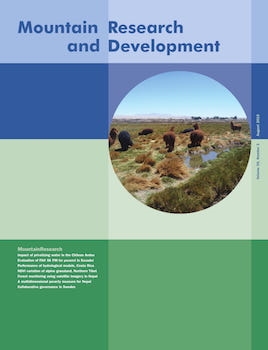Dear Readers,
Just as we were writing this editorial, news reached us that the final version of the Sustainable Development Goals (SDGs), entitled “Transforming Our World: The 2030 Agenda for Sustainable Development” ( https://sustainabledevelopment.un.org/post2015/transformingourworld), had been agreed upon by the governmental preparatory groups on 1 August 2015 and contains a mention of mountains in SDGs 6 and 13, as well as in the 33rd paragraph of the Declaration. The SDGs remain to be adopted at the United Nations Summit on 25 -27 September 2015. The inclusion of mountains is the result of intense lobbying by numerous high-level development agencies and mountain stakeholders worldwide and of concerted international action led by the Food and Agriculture Organization’s Mountain Partnership Secretariat. SDG 6 reads “Ensure availability and sustainable management of water and sanitation for all”; the explicit mountain focus in subgoal 6.6 is “By 2020, protect and restore water-related ecosystems, including mountains, forests, wetlands, rivers, aquifers and lakes.” SDG 15 reads “Protect, restore and promote sustainable use of terrestrial ecosystems, sustainably manage forests, combat desertification, and halt and reverse land degradation and halt biodiversity loss”; and the mountain-relevant subgoals are 15.1: “By 2020, ensure the conservation, restoration and sustainable use of terrestrial and inland freshwater ecosystems and their services, in particular forests, wetlands, mountains and drylands, in line with obligations under international agreements” and 15.4: “By 2030, ensure the conservation of mountain ecosystems, including their biodiversity, in order to enhance their capacity to provide benefits that are essential for sustainable development.” This is not to say that the other 15 SDGs are not applicable to mountains and mountain people; but mountain advocates will have to ensure that they are properly integrated in future mountain policies and activities. At least mountains are now acknowledged in the official SDG document as important terrestrial and freshwater ecosystems delivering crucial services for sustainable development.
Indeed, if we turn to articles on the Andes published in MRD to date, they are often about the vital importance of water. In this Open Issue of MRD, we start with a paper by Manuel Prieto showing how an indigenous population in the high-altitude wetlands of Chile has been dispossessed of its rights to water during the implementation of the water privatization law in Chile, in an area where a water-hungry economic sector, mining, is in need of large amounts of water. Although the local people’s right to the land has been acknowledged, their use of water to maintain the vegas (irrigated wetlands, also called bofedales elsewhere) has not been categorized as agricultural use and therefore not acknowledged as necessary by the government. This ultimately also threatens a uniquely biodiverse environment.
We continue with another Andean (Ecuadorian) water-related paper: Mario Córdova and coauthors reevaluate a well-known method (FAO 56 PM) to estimate evapotranspiration, an important variable in assessing what water is available in times of climatic change. As pointed out by one of the reviewers of this paper, mountains “have much less available actual climate data and many scenarios are based on estimates or models. Checking one such estimate … contributes not only to the usefulness of this particular … estimate, but is indicative of the overall need for good actual climate data in mountain ecosystems.” The next paper, by César D. Jiménez-Rodríguez et al, also focuses on assessing the availability of water for mountain ecosystems in Latin America: The authors test 2 hydrological models for daily flow under a climate change scenario in 2 study areas on both sides of the continental divide between the Pacific and the Atlantic (or Caribbean) climate in Costa Rica.
In the following paper, we turn to water-scarce northern Tibet. Xiaoke Zhang et al analyze the spatio-temporal variations of NDVI of different types of grassland vegetation—the dominant cover in this data-scarce part of the world, covering the 14-year period from 2000 to 2013 and assessing whether vegetation growth is affected by growing season temperature and precipitation. The next paper also measures vegetation trends using remote sensing methods and geographic object-based image analysis: Kabir Uddin and coauthors propose an innovative way of delineating the density of forests in Nepal, with a view to improving the quality of data based on which more sustainable management of this essential natural resource could be achieved.
We remain in Nepal with a paper offering a method to assess the key human variable influencing sustainable development in mountains in the Hindu Kush–Himalaya: poverty. Taking up the state of the art on the debate about measuring poverty, Jean-Yves Gerlitz et al develop a Multidimensional Poverty Measure and analyze results in 23 districts, also examining whether results differ in the mountain, hill, and plain regions of Nepal. Their results illustrate the need for location-specific poverty alleviation strategies. The final peer-reviewed article in this issue of MRD compares the effectiveness of top-down and bottom-up initiatives to negotiate conservation and development in Sweden. Katarina Eckerberg and coauthors show that both approaches are complementary in situations of long-lasting conflict and where public policies have partly failed, such as for nature protection and reindeer grazing; they point out other advantages and disadvantages based on an analysis of a very large project database.
This issue of MRD also offers FAO’s update of its mountain activities and strategy in the MountainPlatform section and ends with 7 book reviews provided by our MountainMedia Editor, Martin Price; Martin and colleagues, by the way, are currently organizing the third global mountain conference in Perth. We look forward to meeting some MRD readers in Perth from 5 to 8 October 2015.





